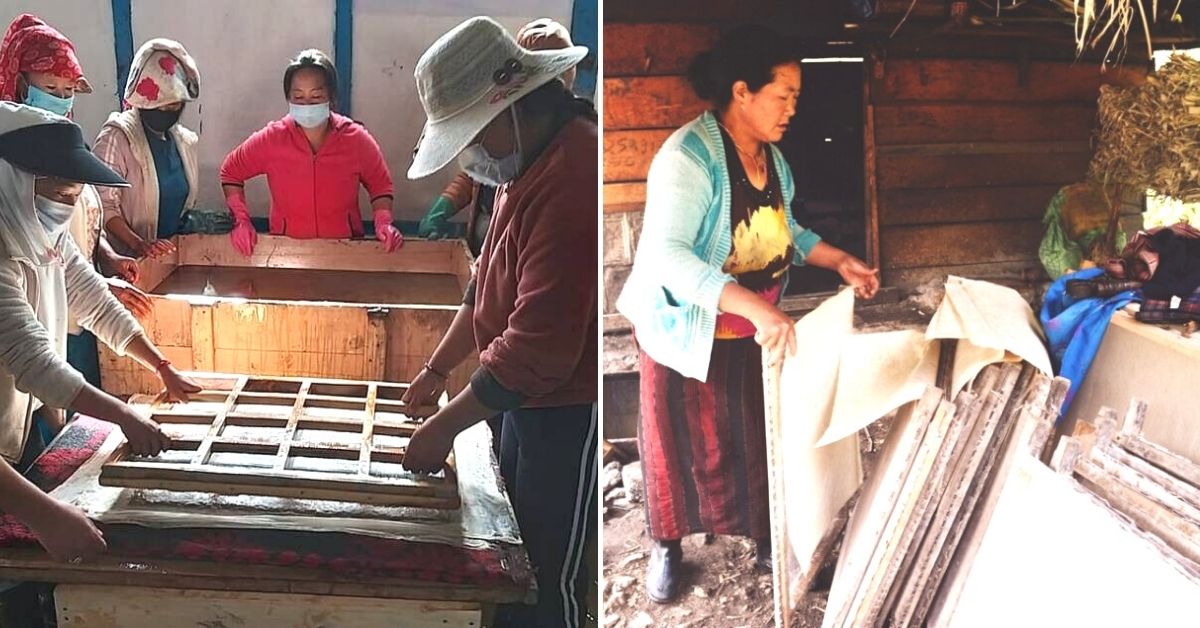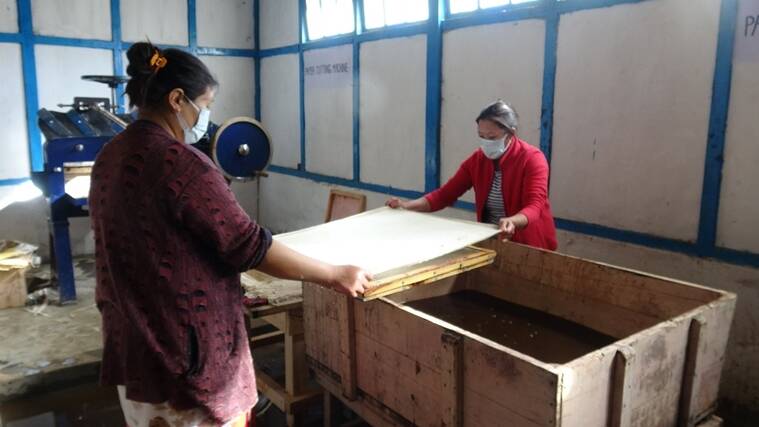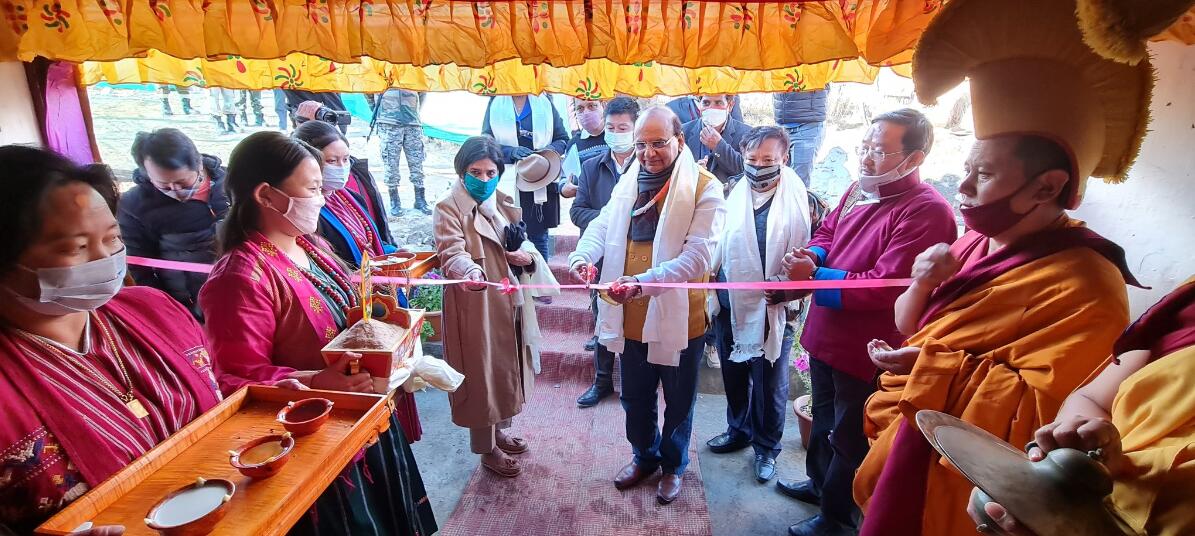Arunachal Is Reviving Its 1000-YO Art of Making Paper That Doesn’t Harm Trees
More durable than conventional paper, Mon Shugu holds a special place in the history of the Arunachal Pradesh’s Monpa tribe.

In February 2020, Maling Gombu, a Tawang-based social worker and lawyer, wrote to the Khadi and Village Industries Commission (KVIC) — a statutory body dedicated to the development of village industries, about the potential of a 1,000-year-old paper-making craft of the Monpa tribe in Arunachal Pradesh that was languishing.
Taking note of his letter, the KVIC took appropriate actions. Following months of planning, which was abruptly halted by the COVID-19 pandemic, the KVIC launched a Monpa handmade paper making unit on 25 December at an erstwhile abandoned government building in Tawang. Called ‘Mon Shugu’, this fine-textured handmade paper is an integral part of Monpa history.
To make Mon Shugu, the inner fibrous bark of the Shugu Sheng shrub (Daphne papyracea) is dried, boiled with a solution of ash, made into pulp and then cut into sheets of paper. The process of making this paper is entirely organic with no chemical additives. This naturally processed paper possesses strong tensile strength and is durable as well.
“It has been observed that the harvesting of the bark starts from March to April and continues till December before flowering and fruiting. During the reproductive stage, people do not harvest it, keeping in mind that there should be no disturbance in natural regeneration and also because there are other alternate resources. Bark harvested during the earlier part of a year is used for paper-making the rest of the year. To make 1-1.5 kilo of bark about four to five plants are required but it varies with the size of the plant. It has been estimated that about 20 to 30 minutes is required to harvest the same amount of bark. At least two sheets of paper (62cm long and 51cm wide) can be made from the bark of one plant,” notes a March 2006 paper titled — A Traditional Source of Paper Making in Arunachal Pradesh.

A canvas for Buddhist scripts
Mon Shugu has long been an integral part of Tawang’s vibrant tribal culture. Its historical significance is undeniable. In centuries past, this fine-textured handmade paper was used for writing Buddhist scriptures and manuscripts in monasteries, among other texts, while the shrub from which it is sourced, Shugu Sheng, also possesses medicinal value.
“The hand made paper is strong with its visible natural fibres and a unique texture. In ancient times the paper was used for writing Mantras, Sutras and Buddhist epics; it is still used for the contents of prayer wheels, but at present it is also used for artistic purposes and for making exquisite gift items,” notes the 2006 paper.
“Back then, such was the scale of production that Monpas used to sell these papers to countries like Tibet, Bhutan, Thailand and Japan as no paper making industry existed in these countries at that time. However, the local industry gradually began declining and the indigenous handmade paper was taken over by inferior Chinese paper,” notes a release issued by the Press Information Bureau of the Government of India on 26 December 2020.
Mon Shugu is no ordinary kind of paper. Compared to conventional paper, it’s lifespan and durability is much longer. Maling also notes that it’s 80 percent stronger in tensile strength.
“The value of reviving Mon Shugu centers on the preservation of our traditional culture and Buddhist heritage. There is a local market for this paper since we employ it for our daily prayers, packaging special items like butter and other uses. But there is also an international market for it in countries like China and Japan where it’s used for writing scriptures and calligraphy. Japanese artists, particularly, use this paper to write calligraphy. But we will have to properly explore those markets before taking any major steps. Meanwhile, KVIC is also buying this paper and marketing it,” adds Maling, speaking to The Better India.

Past Attempts at Reviving Mon Shugu
The traditional way of making Mon Shugu is time consuming, as its raw materials are not easy to source. Besides, its process of boiling, beating, drying and cutting of paper by hand is a very time consuming process as well. Just to generate a sheet of paper, one would require a day. Therefore, the practice was restricted to a few families in villages like Mukto in Tawang district, which is perched at 10,800 ft above sea level. By the late 1990s, the United Nations Development Programme (UNDP) and KVIC came together to modernise the process from its manual roots.
“In 2003, a common facility was set up in Mukto village in Tawang district, where machines like boilers, beaters and dryers were brought to speed up the different processes at play. The KVIC even sent a group of artisans to Jaipur for a training programme on how to utilise these machines at the Kumarappa National Handmade Paper Institute (KNHPI). The new machinery was expected to reduce the time required to make it. For example, the final process of drying was earlier dependent on the sun. But now there is a drier. The boilers, meanwhile, boil larger quantities of up to 20 kilos. However, for this initiative to work, it required a group effort. But the traditional paper makers, comprising six to seven families in Mukto, could not come together and use it,” notes Maling Gombu, speaking to The Better India.
Maling believes that these families found it more convenient to use the traditional method because they were producing only small quantities for domestic use.
“Using the plant needed a coordinated group effort. They had even registered a society under the chairmanship of the Mukto Circle Officer, but even then it did not take off. Last year, we shifted the equipment from Mukto to Tawang since it wasn’t damaged. My NGO, Youth Action for Social Welfare, joined the revival effort. It has been almost a decade since I reached out to the KVIC for the relocation of the plant from Mukto to Tawang,” he adds.
But, there are villages inhabited by the Monpa people that do not permit taking forest produce outside their villages.
“Getting access to a long supply of Shugu Sheng will be difficult. Producing Mon Shugu at a larger scale will be a real challenge because Shugu Sheng is not easily available. It is available in the Mon region, particularly in the Tawang area, Mukto village and Kalaktang town and Morshing village of West Kameng district in a scattered manner. Collecting it at these altitudes is also a challenge. It is currently being produced for the local market, revival of traditional knowledge and preservation of our culture. We are in talks with the forest department about establishing a plantation of the Shugu Sheng shrub to see long term prospects as it takes about three to five years to harvest it,” says Maling.
Another challenge is to encourage the local community to pick up the practice of making Mon Shugu again.
“Not many Mon tribal families took up this practice. It was primarily families in Mukto village and its surrounding areas who were popular for producing this paper. To encourage the younger generation to take up this practice will be a challenge. However, if we take it up, it will generate additional employment. Villagers will collect the raw material from the forest and we can buy it from them. Moreover, the Shugu Sheng shrub has medicinal value, is not eaten by insects and possesses aromatic qualities as well,” says Maling.

‘Local product, with global potential’
The revival of Mon Shugu in Tawang was also taken up in earnest by the KVIC Chairman Vinai Kumar Saxena. On his instruction, a team of scientists and officials at Kumarappa National Handmade Paper Institute (KNHPI) were sent to Tawang to establish the paper making unit and train locals. After six months of extensive work, a unit was set up.
Employing nine local artisans, who earn a daily wage of Rs 400, to make 500-600 sheets of Mon Shugu a day, this is a first step towards reviving this ancient practice of the Monpa people.
To begin with, 12 women and 2 men from local villages have been trained to make this paper. A key objective for Saxena is enhancing Mon Shugu’s commercial potential.
“Owing to its peculiarity, this handmade paper has high commercial value that can be harnessed to create local employment in Arunachal. By increasing production of Monpa handmade paper, it can be exported again to other countries and regain the space occupied by China in the last few decades. This is a local product with great global potential, which is aligned with the Mantra of Local to Global given by the Prime Minister,” Saxena said.
Meanwhile, he went onto laud the Arunachal Pradesh government’s support in this endeavour.
As the PIB press release also goes onto state:
The Monpa handmade paper unit will also serve as a training center for the local youths. KVIC will provide marketing support and explore markets for the locally manufactured handmade paper. KVIC plans to set up more such units in different parts of the country. Saxena said KVIC will also begin production of innovative plastic-mixed handmade paper in Tawang that will be crucial for reducing plastic waste in the region.
Beyond economics, it’s about the preservation of a 1,000-year-old heritage. In incentivising today’s generations of Monpas, there is hope that the people of the hills will finally receive the recognition they deserve for reviving this legacy.
Featured image: Source
(Edited by Yoshita Rao)
Like this story? Or have something to share? Write to us: [email protected], or connect with us on Facebook and Twitter.
If you found our stories insightful, informative, or even just enjoyable, we invite you to consider making a voluntary payment to support the work we do at The Better India. Your contribution helps us continue producing quality content that educates, inspires, and drives positive change.
Choose one of the payment options below for your contribution-
By paying for the stories you value, you directly contribute to sustaining our efforts focused on making a difference in the world. Together, let’s ensure that impactful stories continue to be told and shared, enriching lives and communities alike.
Thank you for your support. Here are some frequently asked questions you might find helpful to know why you are contributing?


This story made me
-
97
-
121
-
89
-
167











